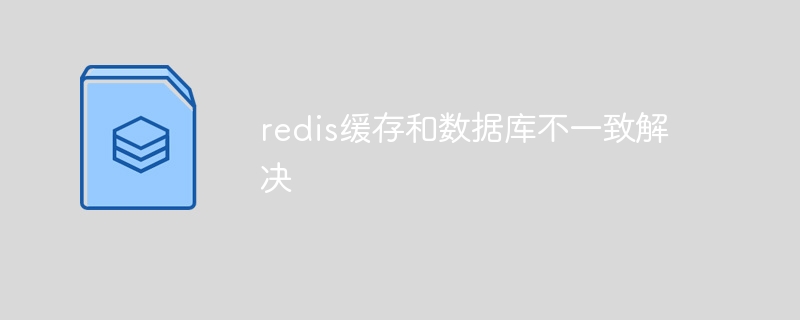Solve the inconsistency between redis cache and database
- 下次还敢Original
- 2024-04-19 18:01:021233browse
Solving the problem of Redis cache and database inconsistency requires: using a data consistency protocol (such as Redis transactions or distributed locks) to prevent concurrent writes from causing inconsistencies. Use cache invalidation strategies (such as expiration times or update triggers) to ensure that the cache is updated in a timely manner. Optimize the cache architecture (such as partitioned cache or second-level cache) to reduce direct access to the database. Continuously monitor and resolve inconsistencies with data integrity checks and alerts.

Redis cache and database inconsistency resolution
When using Redis cache in conjunction with a relational database, you may encounter cache and database data inconsistencies The problem. Addressing this issue is critical to ensure data integrity and consistency.
Cause
The main causes of inconsistency between the Redis cache and the database include:
- Concurrent writing: When multiple clients write to When the database writes data, the Redis cache and the database may have different data values.
- The cache is not updated in time: If the Redis cache is not updated in time after updating the database, inconsistencies will occur.
- Cache breakdown: When high concurrent traffic accesses non-existent cached data at the same time, it will cause the database load to be too high, resulting in inconsistency.
Solution
Common methods to solve the problem of Redis cache and database inconsistency include:
1. Use data consistency protocol:
- Redis transactions: Redis transactions ensure that a series of operations are executed as atomic units, thus preventing data inconsistencies.
- Distributed lock: Distributed lock can lock the database during concurrent writes to prevent simultaneous modifications.
2. Use cache invalidation policy:
- Expiration time (TTL): Set the expiration time for cached data, Make it automatically expire after a period of time and reload from the database.
- Update trigger: When the database data is updated, a mechanism is triggered to update the Redis cache.
3. Optimize cache architecture:
- Partition cache: Partition cache data to multiple Redis instances to Avoid a single instance becoming a bottleneck.
- Second-level cache: Use secondary caches such as Memcached to reduce direct access to the database.
4. Monitoring and alerting:
- Data integrity check: Regularly check whether the data in cache and database consistent.
- Alerts and Notifications: Set alerts to notify relevant personnel when inconsistencies are detected.
Conclusion
Solving Redis cache and database inconsistencies requires a comprehensive approach, including the use of consistency protocols, cache expiration strategies, optimized architecture, and continuous monitoring. By following these best practices, you can ensure cache and database data are consistent, improving application reliability and accuracy.
The above is the detailed content of Solve the inconsistency between redis cache and database. For more information, please follow other related articles on the PHP Chinese website!

